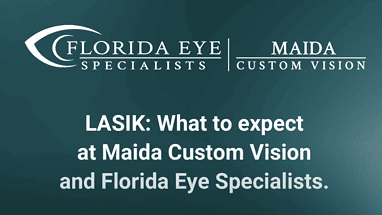Hear from our Clinical Director and Laser Suite Supervisor, D.D. Jewell, about what you can expect during your complimentary LASIK…
LASIK and 20/20 Vision

In the early days of LASIK, one of the selling points of the new technology is that it offered patients the possibility of achieving “20/20 vision or even better” without the need for glasses or contact lenses. And, in fact, many patients were able to achieve such visual independence, with some actually being able to reach the rarified heights of 20/15 vision after undergoing LASIK. Yet, as many patients commented, 20/20 vision or better did not necessarily mean perfect vision. Why was this?
Even now, when discussing the issue of LASIK and 20/20 vision during consultations at their Jacksonville, FL eye care center, the ophthalmologists of Maida Custom Vision have to explain that the quality of one’s vision is not fully expressed in the traditional means of measuring visual acuity (e.g., “20/20”). The quality of your vision is better understood in terms of lower-order versus higher-order aberrations, as you will learn in this blog post.
At Maida Custom Vision, we have the technology and the skills to provide our patients with the best possible results through fully customized LASIK surgery. If you would like to learn whether you are a good candidate for LASIK, we invite you to schedule your initial consultation at Maida Custom Vision today.
Traditional Measurement of Visual Acuity
If you are of a certain age, then you probably remember very well what it was like to watch television in standard definition. There was nothing noticeably wrong with it – at least until you experienced high-definition television. Now, whenever you watch a television program produced, say, 30 or even 20 years ago, it probably looks out of focus and somewhat blurred, with less vivid colors and fuzzy edges.
Those images were, at the time, probably as clear as they could have been – and, at the time, they probably looked great. We see now, however, that they were flawed and could be improved.
Likewise, if you suffer from low-order aberrations – the universal visual errors known as nearsightedness, farsightedness, and astigmatism – these can be relatively easily fixed. For centuries, people have been using eyeglasses to correct these errors; for decades, contact lenses have been available. With these lenses, it has been possible to achieve 20/20 vision by correcting these low-order aberrations.
In the early days of laser vision correction, LASIK could also correct these errors – to the same degree that glasses and contacts could. What none of these methods of vision correction could do was treat higher-order aberrations, or the tiny imperfections in the shape of the cornea that were unique to each individual eye. These higher-order aberrations could not be detected accurately by any means – until, that is, wavefront mapping technology came along.
Now, by combining wavefront mapping technology with the precision of the excimer laser, it is possible to correct both lower-order and higher-order aberrations through LASIK surgery. The improvement in results is potentially similar to the improvement between standard-definition television and high-definition television.
Learn More about LASIK and 20/20 Vision
To learn more about how you can achieve outstanding vision through custom LASIK, please contact Maida Custom Vision today.



